

Crowds of people funneled past me as I unloaded my sampling equipment from the back of a taxi in Cameroon’s Kumba Market. The driver helped me pull my gear from the trunk: a huge backpack, a sack of gillnets, a 20-liter jug of ethanol, a woven fish trap and my camera. As the equipment appeared, the crowd seemed to close in on us, with a group of young boys jockeying for position with handcarts to transport my effects.
Unfortunately for them, I was looking for a motorcycle taxi instead. I paid and thanked the driver, then told the crowd that I was looking for a ride to Barombi Kotto. Five motorcycles shot through the people and nosed onto my gear, all shouting prices and grabbing my bags and arms, practically dragging me onto their bikes. A ride to Barombi Kotto runs about 10,000 FCFA — about $20 — a big boon for a mototaxi driver who typically makes 20 cents per customer. I chose the oldest moto-man and we began to load my equipment — all except my camera, which I carried so I could photograph the journey.
I’m sure I was smiling ear to ear — after all, I was living out a childhood dream. I’ve loved to fish since before I knew what love was. Growing up in Coastal California, I always had a fishing rod in hand. My brothers and I would have annual fishing tournaments, and things got competitive. By age eight, I was rigging my gear, tying my knots and driving the boat out to go trolling for bass at sunrise. As I grew older, my love of fish matured. I began to notice the characteristics that distinguish one species from another, and the minute differences between individuals within a species. I dug deeper and deeper into fish taxonomy and by the time I was an undergraduate student at UC Davis, I was a certified fish head.
As I was finishing my undergraduate studies, I applied to the Peace Corps and was assigned to Cameroon. I didn’t pack much, but I did bring my fishing pole. I served in a small mountain town named Bangem, and there were a few volcanic lakes nearby. I looked online to find out if any of the lakes had fish in them, but found next to no information. The result? I went to the lakes to find out for myself. In doing so, I became the first scientist to sample from Lake Bermin in 25 years. This research launched me into the Evolution and Ecology PhD program at UC Santa Cruz, where I currently study the diversity and conservation of African freshwater fishes.
I returned to Cameroon in 2015 with funding from National Geographic to study the rest of the lakes in the South West Region. For four months I fished every lake, river, swamp and bog I could find, with the goal of cataloging freshwater diversity to identify biodiversity hotspots and promote conservation. My next stop was Barombi Kotto.
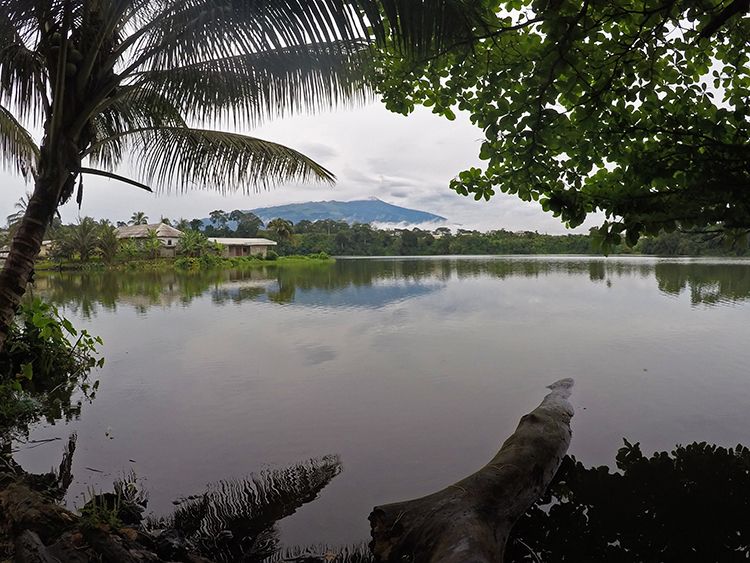
I told my moto-man that I wanted to meet the chief of Barombi Kotto to arrange my visit. He informed me that the chief lives on an island in the middle of Lake Barombi Kotto, but that he knew some fishermen who could take me across once we got to New Town. When we arrived, I unloaded my things on the dusty roadside, attracting an audience of local fishermen. One shouted from the crowd, “Hey whiteman, weti you di do here?”
I replied, “I wan go for Barombi Kotto, I wan tok with Chief.”
The fishermen smiled. They liked it when a stranger spoke pidgin. The same man who had originally called out said the Chief was in Barombi, but that a local could take me over in his father’s boat.
At that, a young man stood up and walked up to me. He introduced himself as Rudolph and crushed my hand in a friendly handshake before pulling at my nets. He said, “You no go get plenty fish dem with dis kind net. E dey too big. We get for cast net em.”
I told Rudolph that I had been fishing for months and already collected thousands of fish with my gillnet. He brushed me off. “You no go get plenty dem. You go tok for chief, ask he if you fit cast net em.”
I began loading myself up with gear, but Rudolph laughed and told me, “Leave em, those pikin dem go helep you for carry em.” A group of young boys appeared, and began picking up my bags and balancing them on their heads.
Rudolph led the way down the street. At the next corner, we turned left and were suddenly at the edge of the crater rim. In front of us lay a huge lake with a large, well-developed island smack in the center. Small canoes were passing between the island and mainland, birds filled the sky and the jungle closed in on the shore of the lake.
We walked down the last stretch of muddy trail, and Rudolph darted off into the bushes to retrieve a paddle. Each hand-carved canoe on the main beach was unique, though some were larger and looked more seaworthy than others.
Rudolph reappeared with a big smile on his face and walked directly to the smallest, oldest, wettest canoe. He proudly declared, “Dis canoe belongs to my father.” I smiled back, relieved that most of my equipment was waterproof.
Before long, we bumped onto the muddy shore of the island of Barombi Kotto. The air seemed quiet. Other than a few elderly people and children, the place appeared deserted. Rudolph led me to the chief’s palace, but the chief was out; like most of the adults in the village, he was out working on his farm. Rudolph and I sat in the foyer of the chief’s palace and looked at Mount Cameroon across the lake. I remember thinking, “This might be the most beautiful place I’d ever seen.”
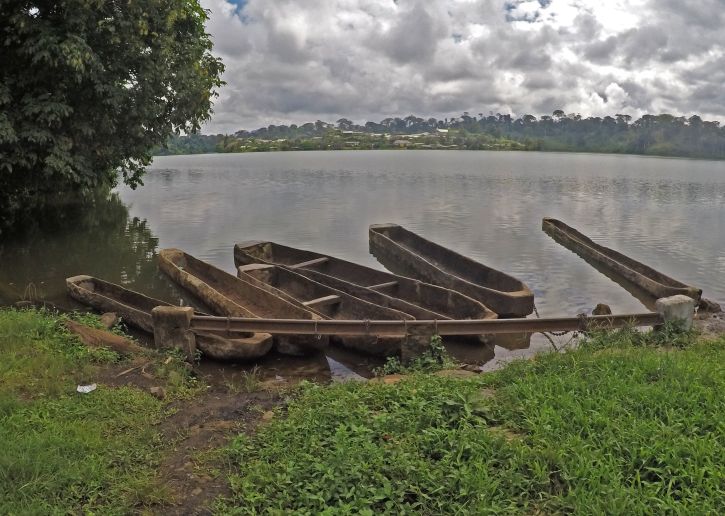
Rudolph was able to arrange a meeting with the chief and traditional council, and that evening I sat in the chief’s palace with the village elders. The chief was the last to arrive; it seems he was also the last person to hear of the meeting that was to be held at his home. The rest of us were already enjoying beers, so I handed him two bottles and told him he was right on time.
After I introduced myself, the Chief replied, “We thank you, Mr. Joseph, for coming to our village, and for your interest in our lake. You can stay in my home, and fish with Rudolph, so long as you pay him. We wish you success in your mission here, and welcome you to Barombi Kotto.” I was rapidly falling in love — with the village, the people and the lake.
I was eager to learn from the locals and the village elders were happy to oblige. They told me the fishing was not as good as it used to be. Their fathers had been fishermen, but they had turned to farming because they couldn’t compete with the frozen fish market. They told of their fears that their children would have to leave the island to look for work, that they might even forget how to fish. Their shudders told me they considered fishing as the most fundamental part of being Barombian.
I asked them if they could name all the fish in the lake, as I was hoping to pair local terms with scientific names. I grabbed my notebook and wrote down names as they were listed: kurukuma, mbonge, kibundu, kamabundu, finjongo, ngete, lenge, fikunle, pindu, ntandt, longo katta, fibus, nyongo, paragon . . . I could barely keep up.
According to scientific literature, there are only seven known fish species in Lake Barombi Kotto and four additional species in the inlet stream. Unsurprisingly, the Barombi people know the fish better than the scientists do. They also told me that the kurukuma are not as common as they used to be, and that the community had banned cast netting for five years to allow the populations to recover.
I was excited. Not only were the people warm and welcoming, but they were also aware of and concerned about their fishes. What a place to be an ichthyologist! Though the chief gave me a nice bedroom, I hardly slept that night. I was too eager to start fishing.
The next day, after Rudolph and I set the gillnets, we paddled into the inlet stream, Tung Nsuia. The inlet was very brushy, and we pushed vines from our path as we glided deeper into the forest. We “parked” the canoe and I climbed out with my dip net. I began by scraping the banks of the creek to trap the juvenile fishes that were hiding among the roots. Rudolph followed behind me with a huge plastic bag, half-filled with water for the catch.
I caught a few Hemichromis, Enteromius and Chromidotilapia, and the fish were beautiful. The Hemichromis are also known as jewel cichlids, each fish had a bright red chin and underbelly, brilliant green spots along its flanks, a band of black across its eyes and five black spots along its midline. The Enteromius were silver and sleek, with bright orange eyes, a black spot on their dorsal fins and orange lobes on their tail fins. The Chromidotilapia were perhaps the most extraordinary. The males had vibrant pink bellies and a turquoise-blue sheen to their pelvic fins. The dorsal and tail fins were spotted and had a metallic golden sheen to them. I was in heaven.
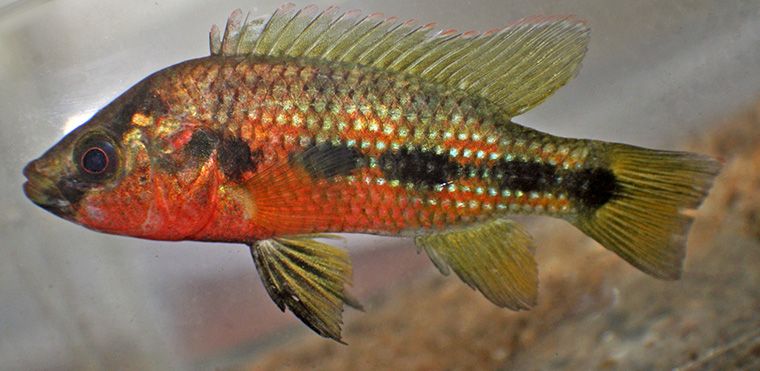
As we moved down the creek, I discovered that the left bank was heavily undercut. I put my dip net as far under the bank as I could but couldn’t find the end, so I held my breath and ducked under. The warm water was dark and muddy. Exposed roots protruded from the bottom of the bank — a perfect habitat for fishes. I was about four feet under the bank before I found the back wall. After scraping it, I returned to the surface with a heavy net. I wiped the water from my eyes, looked in the net and started shouting with excitement.
I had five mormyrid fishes (commonly referred to as elephant fishes). No scientist had everreported collecting a mormyrid from Barombi Kotto and even Rudolph told me he had never seen that fish before. Within an hour of sampling, we had already discovered a new species for the system!
That night I was all abuzz. I set up my aquarium at the chief’s palace to photograph the live fishes. Groups of villagers crowded around me and began identifying specimen. When I pulled out the mormyrid, the villagers spoke amongst themselves in the dialect. The chief told me, “We don’t know that fish. Maybe that’s one of the new fishes that were put in the lake.” I asked him for clarification. The chief replied, “Last year, one of our elites brought live fishes that grow big and put them in the lake. We don’t have a name in dialect for them but they grow fast and we can sell them at the market.”
Many people in the crowd agreed that this fish must have been introduced as a food fish. I felt two emotions: concern and skepticism. Introducing a non-native species into a unique volcanic crater lake ecosystem like Kotto could have devastating effects on the native biodiversity. But who would choose a mormyrid as their food fish? Mormyrids are not big and they do not grow quickly. Moreover, they are nocturnal and difficult to catch using traditional fishing methods. Why would someone introduce this species here? Perhaps, the food fish the villagers were discussing was not mormyrids. Perhaps there were other discoveries yet to be made.
Every day for the next two weeks, the lake was my sampling grounds, including the lake’s outlet and two inlet streams. My sampling produced many specimen of the common species, but also more discoveries. While dip-netting the outlet, I caught a beautiful species of killifish that had never been collected in Barombi Kotto. I was in great spirits.
One night I went to visit a witch doctor and fisherman, Mboke Claytus, in his compound. We settled into wooden chairs with kerosene lamps above us and cold beers on the mud floor beside us. His daughter brought us steaming pots of food, and I asked about the dried fish in the soup. Mboke looked away, searching his memory for the name. Then he replied, “We call it knot fish in pidgin. We buy it from the ocean.”
Xiphophor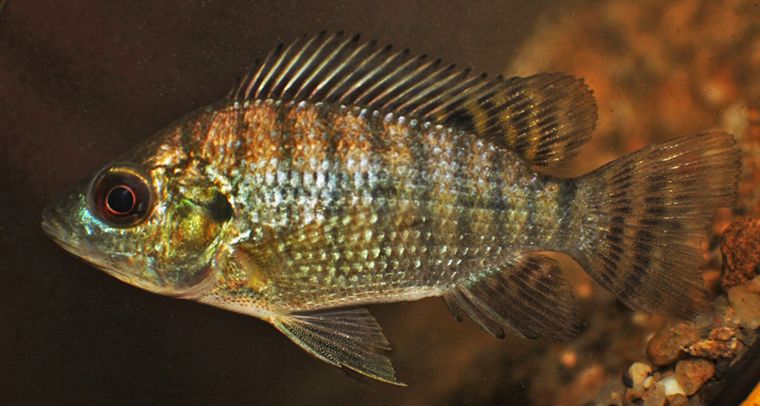
Suddenly, I realized we were eating smoked moray eel. On an island, inhabited by fishermen, I was eating store-bought fish in the house of a fisherman. I asked Mboke why he would buy fish. He told me, “We cannot fish anymore in Lake Barombi.”
I was confused. He clarified by saying, “Barombi men fish with cast nets, but our ancestors told us to stop fishing with cast nets. It came to me in a vision that we must stop fishing the lake for five years. Then the ancestors will be pleased and we can begin fishing again.” Mboke is too proud a Barombian to consider hook-and-line fishing or gillnetting.
I was surprised and impressed by the awareness of the need for conservation, something I had not witnessed on the nine other lakes I had already visited in Cameroon (though perhaps it was blossoming there without my knowledge).
On Day 12 at the lake, I hiked up the inlet stream and fished within the cocoa fields. Blocking the stream with my seine, I waited while Rudolph ran downstream to spook fishes into the net. We soon caught something huge. I grabbed the fish and identified the specimen as an adult Nile tilapia, Oreochromis niloticus.
My heart dropped at the confirmation that invasive Egyptian fish were living in Lake Barombi Kotto. Rudolph noticed my reaction and asked me what was wrong. I told him, that when I first arrived at Lake Barombi Kotto, scientists only knew of 11 species in and around the lake. Now we know there are at least 15. How many of those species were introduced by man? How many will survive the most recent introductions? Barombi Kotto’s endemic fishes are now at risk because invasive species may out-compete them, eat their babies and maybe even drive them to extinction. Lake Barombi Kotto is the second-most diverse lake in this part of Cameroon, and now it is an experiment for species introductions. We don’t know what will happen.
Rudolph rolled his eyes and told me, “Dey tasty, and you fit sell em. You no fit sell small small fishes dem. You fit sell this one.”
For Rudolph, Mboke Claytus and the Barombi people, fish are a natural blessing. Generations of Barombians have caught, eaten and sold fish, managing their fisheries using traditional methods. But as global markets change and local markets are flooded with frozen mackerel, the fishermen have had to become farmers. Farmers value productivity and when they do go to fish, they want a large, marketable fish. From a strictly economic standpoint, it’s possible that Barombi villagers might prefer a monoculture of Nile tilapia to a diverse aquatic community.
As an ichthyologist and biodiversity lover, I was horrified by the introduction of Nile tilapia. But who am I? I spent a total of two weeks in Barombi Kotto. The Barombians spend generations. I’ll go home to California and spend my summer fishing for non-native catfish and bass in Clearlake, and be one of the millions of fishermen who support a multibillion dollar recreational fishing industry. Why should the Barombi people be denied the opportunity to develop this industry?
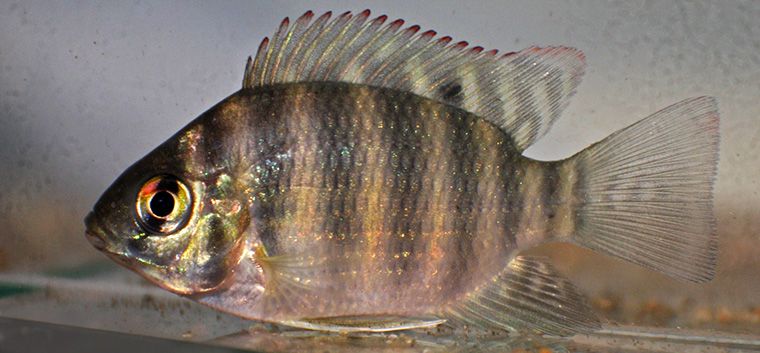
Only with time will we know the effects of the introduction of tilapia into Barombi Kotto, but it is critical that we assess the impacts of invasive species, inform conservationists and policymakers, and avoid potentially-devastating introductions into any of the other lakes in Cameroon’s volcanic crater lake system.
The conservation actions that the Barombi Kotto community has put in place are a great step in the right direction, but not a long-term solution. Environmentalists working in developing countries should support and develop local conservation efforts, like those initiated by the people of Barombi Kotto. Cameroon’s volcanic crater lakes, including Barombi Kotto, have been highlighted by the international community for future action and may soon be protected. By working with local communities, we can fight the global biodiversity crisis together.
All photos are owned by Joseph Cutler and may not be used or reproduced without permission.